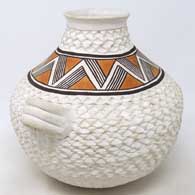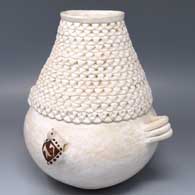Corrugated Pottery

Jessie Garcia
Acoma

Stella Shutiva
Acoma

Jackie Shutiva
Acoma
Most corrugated pottery is made by coiling a pot but instead of using a piece of gourd (or something with a similar hard, sharp edge) to smooth the coils on the outside, like most other pots, a finger or tool is used to make regular indentations in the coils. Sometimes the coils are smoothed and a tool used to add corrugation to the smooth surface after. Corrugation often covers an entire piece but is also sometimes used in bands to decorate pots in a manner other than painting, carving or etching.
The corrugated pottery pattern was revived by Jessie Garcia after she came across corrugated potsherds lying on the ground near her home at Acoma. They were left over from the work of unknown potters hundreds of years ago.
A corrugated cooking jar offers more surface area to a fire: it heats up faster and the heat distribution is more even. As a design pattern she felt she could make uniquely her own, Jessie spent years perfecting it. Then she taught her daughter, Stella Shutiva, how to make it and Stella perfected it further. Stella even traveled to the Smithsonian Institute in Washington DC in 1973 to demonstrate how she made her corrugated wares. Then Stella taught her daughter, Jackie Shutiva, how to do it. Today, Jackie is the premier producer of corrugated pottery at Acoma, and she, too, has developed her own styles and forms.
(505) 986-1234 - www.andreafisherpottery.com - All Rights Reserved
